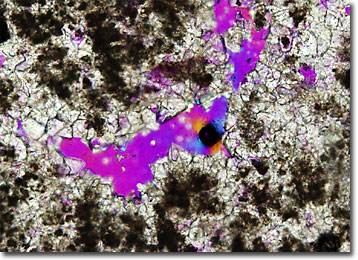Polarized Light Microscopy Digital Image Gallery
Travertine
Travertine is a crystalline form of calcite that occurs in massive form. The material is most often found around the rims of hot springs and streams because it develops through the separation of calcium carbonate from water via the process of evaporation.

Typically banded, travertine is generally quite beautiful in appearance, exhibiting a variety of colors depending upon the impurities it contains. The material, which is also easy to cut and highly polishable, therefore, is often utilized as an ornamental stone. It is sometimes better known as Egyptian alabaster, onyx marble, or Mexican onyx when sold commercially for interior walls, floors, balustrades, stairways, and similar items. Travertine is also often utilized in combination with other types of marble, further increasing the magnificence of many decorative objects it is commonly utilized to construct.
The term travertine derives from an old Roman name for Tivoli, an Italian town where large deposits of the calcium carbonate can be found. Travertine quarried in Tivoli under the late Roman republic as well as the early empire was an extremely popular building material. It was, for instance, utilized to create the exterior of the famous Coliseum in Rome. Significant deposits of travertine also occur at Mammoth Hot Springs in Yellowstone National Park, Wyoming and various other locations around the world where limestone is common and calcium carbonate is present in circulating ground water.
